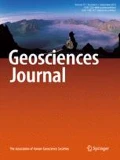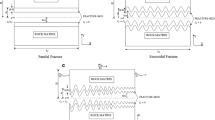Abstract
A variable aperture model, instead of a conventional parallel plate model, is utilized to study the transport of radionuclides in a single coupled fracture-matrix system. A fully implicit finite difference model has been developed, which incorporates fracture aperture width variation in the numerical study of two species radionuclide transport. Two distinct geometric profiles namely, sinusoidal and logarithmic have been used to capture the variation of aperture width. The dependence of advection, hydrodynamic dispersion, linear sorption, and matrix diffusion on aperture width is considered in the analysis of radionuclides transport. Two species (parent and daughter) radioactive decay chain is also incorporated. There is a greater retardation of radionuclides in fracture for the variable aperture model than the parallel plate model. Sensitivity analysis on fracture surface sorption coefficient, longitudinal dispersivity, matrix porosity, and matrix diffusion coefficient shows that the conventional parallel plate model overestimate the radionuclide concentration in the fracture when compared to the variable aperture model.
Similar content being viewed by others
References
Bauer, P., Attinger, S., and Kinzelbach, W., 2001, Transport of a decay chain in homogenous porous media: analytical solutions. Journal of Contaminant Hydrology, 49, 217–239.
Feder, J., 1988, Fractals. Plenum Press, New York, 283 p.
Hakami, E. and Barton, N., 1990, Aperture measurements and flow experiments using transparent replicas of rock joints. Proceedings of a regional conference of the International Society for Rock Mechanics on Rock Joints, Loen, June 4–6, p. 383–390.
Harr, M.E., 1962. Groundwater and seepage. McGraw-Hill, New York, 315 p.
Keller, K. and Bonner, B.P., 1985, Automatic, digital system for profiling rough surfaces. Review of Scientific Instruments, 56, 330–331.
Liu, E., 2005, Effects of fracture aperture and roughness on hydraulic and mechanical properties of rocks: implication of seismic characterization of fractured reservoirs. Journal of Geophysics and Engineering, 2, 38.
Long, J.C. and Ewing, R.C., 2004, Yucca Mountain: Earth-science issues at a geologic repository for high-level nuclear waste. Annual Review of Earth and Planetary Science, 32, 363–401.
Lester, D.H., Jansen, G., and Burkholder, H.C., 1974, Migration of radionuclide chains through an adsorbing medium. Battelle Pacific Northwest Laboratories, Richland, 6, 44. (BNWL-SA-5079; CONF-750329-2).
Liu, Q.Q. and Fan, H.G., 2011, An approach to estimate the flow through an irregular fracture. Proceeding of the 6th International Conference on Fluid Mechanics, Guangzhou, June 30–July 3, 1376, 382–385.
Malik, P.K., 2004, Dye removal from wastewater using activated carbon developed from sawdust: adsorption equilibrium and kinetics. Journal of Hazardous Materials, 113, 81–88.
National Research Council, 1990, Rethinking high-level radioactive waste disposal: a position statement of the Board on Radioactive Waste Management. National Academy Press, Washington, D.C., 38 p.
Natarajan, N. and Suresh Kumar, G., 2010a, Radionuclide and colloid co-transport in a coupled fracture-skin-matrix system. Colloids and Surfaces A: Physicochemical and Engineering Aspects, 370, 49–57
Natarajan, N. and Suresh Kumar, G., 2010b, Solute transport in a coupled fracture-matrix system with sinusoidal fracture geometry. International Journal of Engineering Science and Technology 2, 1886–1892.
Neretnieks, I., 1980, Diffusion in the rock matrix: an important factor in radionuclide retardation. Journal of Geophysical Research: Solid Earth, 85, 4379–4397.
Silveira, C.S.D., Alvim, A.C.M., and Rivero Oliva, J.D.J., 2013, Radionuclide transport in fractured rock: Numerical assessment for high level waste repository. Science and Technology of Nuclear Installations, 2013, 1–17. DOI:10.1155/2013/827961
Srinivasan, V. and Clement, T.P., 2008, Analytical solutions for sequentially coupled one-dimensional reactive transport problems–Part I: Mathematical derivations. Advances in Water Resources, 31, 203–218.
Steefel, C.I. and Lichtner, P.C., 1994, Diffusion and reaction in rock matrix bordering a hyperalkaline fluid-filled fracture. Geochimica et Cosmochimica Acta, 58, 3595–3612.
Sudicky, E.A. and Frind, E.O., 1982, Contaminant transport in fractured porous media: Analytical solutions for a system of parallel fractures. Water Resources Research, 18, 1634–1642.
Sudicky, E.A. and Frind, E.O., 1984, Contaminant transport in fractured porous media: Analytical solution for a two-member decay chain in a single fracture. Water Resources Research, 20, 1021–1029.
Suresh Kumar, G., 2008, Effect of sorption intensities on dispersivity and macro-dispersion coefficient in a single fracture with matrix diffusion. Hydrogeology Journal, 16, 235–249.
Suresh Kumar, G., 2009, Influence of sorption intensity on solute mobility in a fractured formation. Journal of Environmental Engineering, 135, 1–7.
Suresh Kumar, G., 2014, Mathematical modeling of groundwater flow and solute transport in a saturated fractured rock using dualporosity approach. Journal of Hydrologic Engineering, 19, 04014033. DOI: 10.1061/(ASCE) HE.1943-5584.0000986
Tang, D.H., Frind, E.O., and Sudicky, E.A., 1981, Contaminant transport in fractured porous media: Analytical solution for a single fracture. Water Resources Research, 17, 555–564.
Vandenbosch, R. and Vandenbosch, S.E., 2007, Nuclear waste stalemate: Political and scientific controversies. University of Utah Press, Salt Lake City, 331 p.
Vieno, T. and Nordman, H., 1994, Safety assessment of disposal of spent fuel. Espoo: Technical Research Centre of Finland, VTT Publications, 177, 269 p.
Witherspoon, P.A., Wang, J.S.Y., Iwai, K., and Gale, J.E., 1980, Validity of cubic law for fluid flow in deformable rock fracture. Water Resources Research, 16, 1016–1024.
Yamashita, R. and Kimura, H., 1990, Particle-tracking technique for nuclide decay chain transport in fractured porous media. Journal of Nuclear Science and Technology, 27, 1041–1049.
Young, W.Y., Chang, H.C., and Chang, L.K., 1992, Analytical solution for a three member decay chain of radionuclide transport in a single fracture porous media. Journal of Korean Nuclear Society, 26, 453–460.
Zhu, J., Pohlmann, K.F., Chapman, J.B., Russell, C.E., Carroll, R.W., and Shafer, D.S., 2011, Sensitivity to formation porosity of contaminant transport from Nevada test site to Yucca mountain. Journal of Hazardous, Toxic, and Radioactive Waste, 15, 219–227.
Zimmerman, R.W. and Bodvarsson, G.S., 1996, Hydraulic conductivity of rock fractures. Transport in Porous Media, 23, 1–30.
Author information
Authors and Affiliations
Corresponding author
Rights and permissions
About this article
Cite this article
Bagalkot, N., Kumar, G.S. Numerical modeling of two species radionuclide transport in a single fracturematrix system with variable fracture aperture. Geosci J 20, 627–638 (2016). https://doi.org/10.1007/s12303-015-0006-5
Received:
Accepted:
Published:
Issue Date:
DOI: https://doi.org/10.1007/s12303-015-0006-5




